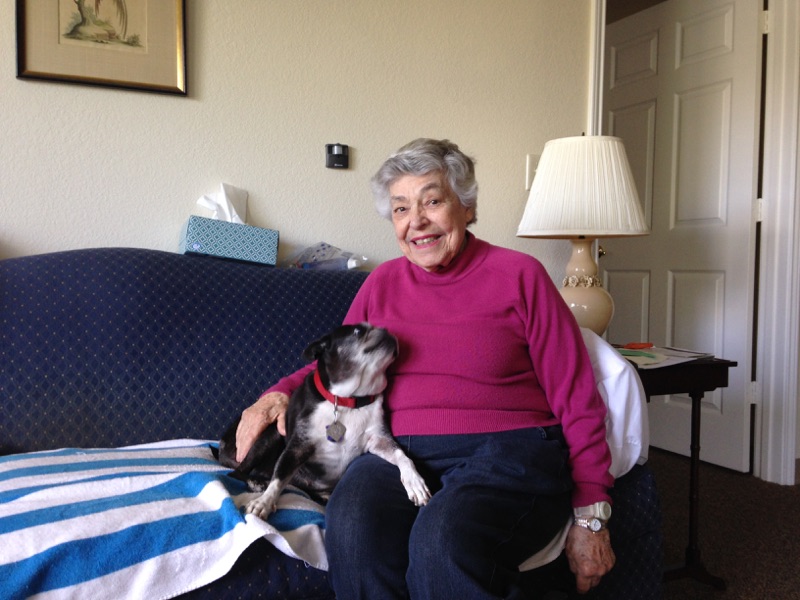How does a Care Recipient’s Pet Affect Caregiving?
 Jessica Bibbo, doctoral student at the University of Missouri, is studying aging, caregiving, and human-animal interaction. The focus of her dissertation is caregiving for adults age 50 and over and their care recipients’ pets.
Jessica Bibbo, doctoral student at the University of Missouri, is studying aging, caregiving, and human-animal interaction. The focus of her dissertation is caregiving for adults age 50 and over and their care recipients’ pets.
Recently, Jessica wrote to The Caregiver’s Voice requesting help with finding caregivers to help her complete this research. Please read her email below (edited) and then click on the link at the end for more information or write to her.
Many features of everyday life influence the caregiving experience (for example, the time spent each week providing care with competing roles such as being a spouse or parent). However, one aspect of everyday life which has been overlooked by researchers is the care recipient’s pet.
Providing care for a pet could exacerbate the stress and strain often experienced in the caregiving role by adding to the time spent as a caregiver for a loved one. Yet, caring for the care recipient’s pet may potentially benefit the caregiver. Additionally, caring for people who are motivated to maintain and/or improve their level of functioning — which pet owners may be — is likely to have a positive impact on the caregiving experience. Caregivers may benefit indirectly via their loved ones’ sharing emotional bonds with another living being.
Interaction between care recipients and their pets may be beneficial if it encourages social and cognitive engagement. Unfortunately, there is no scientific literature on this potentially important topic.
My dissertation will explore the influence of care recipients’ pets on the caregiving experience. The results will provide insight into how caregivers perceive the roles of pets in the lives of their care recipients. Most importantly, the results will begin to uncover how the relationships between caregivers, care recipients, and care recipients’ pets shape the experience of caregiving.
 The findings may have practical implications for in-home, caregiving support services, and the relationships between caregivers and their care recipients. Both family and in-home caregivers allow individuals to remain in their homes longer, and they may allow people to stay with their pets longer as well.
The findings may have practical implications for in-home, caregiving support services, and the relationships between caregivers and their care recipients. Both family and in-home caregivers allow individuals to remain in their homes longer, and they may allow people to stay with their pets longer as well.
People with pets value their relationship. Adults often describe their pets as family members whom they love. Older adults choose to live with pets for companionship and the comfort and joy shared through physical affection.
The special emotional bond becomes more significant as physical health declines. Additionally, this bond is important for elders with few human companions. A recent study [link to abstract] reported that people with Alzheimer’s disease who had difficulty interacting with other people, found that pets provided them companionship and a way to connect with another being.
However, people who require assistance with the activities of daily living, are likely to need help with their pets as well, leaving more work for the caregiver. There is very little known about how care recipients’ pets impact the lives of caregivers who play an invaluable role.
I invite you to participate in this study if you are providing care for a person 50 years or older who has a cat or dog. [Currently, the study is focusing on cats and dogs.] Participation involves completing an anonymous online survey that takes between 35 to 45 minutes to complete. You may have your own pet(s), but not consider your care recipient’s cat or dog to be your own pet.
If you would like to participate please click on the link: [Study link no longer operational]
If you would like to participate or learn more about this study, please contact me by email: jlbnq7@mail.missouri.edu.
Thank you.
Jessica Bibbo
Doctoral Candidate
Research Center for Human-Animal Interaction
University of Missouri, Columbia









I was told that some of you are wondering what the deadline is to respond to the study. It would be most helpful if you could participate Friday June, 3rd. However, the study link will up active through the summer. Thanks again!
Jess
My mom is 89 years old and rarely goes outside. I come to visit 4-5 days per month. This last time she needed me to go take her car in for a recall that took 5 hours plus travel time. I had my dog with me as always since my Mom loves seeing her. Since I would be waiting so long at the dealership he suggested that I leave my dog with her at home. I was surprised to see my Mom actually up and dressed when I got home, even though I had told her to just let Pax out in the back to go potty. Unless we go to the bank or store my Momnever dresses, yet taking care of Pax had her up, dressed and cheerful.
Awww, that’s such a sweet story, Michele. Thank you for sharing it.
Thank you for sharing your story, Michele. Very interesting that your dog got her “up, dressed, and cheerful.” The fact that it wasn’t for her own dog is unique. There is not much research on how other people’s pet influence behavior – what a terrific example you provided.
Thank you very much to The Caregiver’s Voice community!
While I cannot say if the completed surveys were from people from this site, I have had a number of people complete the survey this week. I hope the results of my study can help caregivers, those they care for, as well as the their beloved pets.
Thank you for all you do.
Jess
Our pleasure, soon-to-be, Dr. Jess!
One of our folks replied via Facebook that he completed the survey.
Hope it helps.
One by one, you’ll get enough to help further research on the impact of care receivers pets on the caregiving situation.